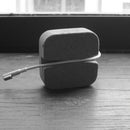Introduction: Tres Lamp
For my third project as an Instructables Artist in Residence, I set out to design a simple yet sturdy desk lamp that almost anyone could make. Drawing inspiration from scrap project materials and Hoang M Nguyen's "Lampfire", Tres Lamp is a customizable lamp that can be constructed with the most basic of tools.
Step 1: Tools & Materials
Tools
• Ruler
• Pencil
• Scissors
• Protractor
• Hand saw
• Utility knife
• Wire cutters
• Sand paper
• Electrical tape
Materials
• (3) 1/2" Diameter wooden dowel rods cut to 20" length
• Natural fiber cording (at least 54")
• Large scrap piece of cardboard (at least 14" square)
• Light bulb (E26)
• Lamp socket (E26)
• Electrical cord
• Electrical plug
Helpful Links
With all the different choices in bulbs, sockets, and cords, you can really have a lot of fun outfitting this project. I found most of my components in a great little shop on Etsy called SnakeHeadVintage. The rest of the materials you should be able to find at your local hardware store.
Step 2: Create the Template
Making a simple cardboard template will help keep the dowels in place while you're hands are busy tying the knot in step 8. Use a ruler and protractor to measure out a 12" equilateral triangle. Poke holes at each of the three points for the dowels to stand in later.
Step 3: Make the Feet
This little detail will allow the tripod structure to sit flush on any flat surface. This will help create a more finished look in the end product. Use a pencil to mark a point about 1/4" away from one end of each dowel. Use the hand saw to make angled cuts tangent to those marks. Use a low or medium grit sandpaper to clean up the ends of each dowel afterwards.
Step 4: Make the Notch
This step will help to create the tripod structure with the use of just a single knot. Mark a line about 5" from the top of one of the dowels and cut about 1/3 of the way deep. Leave the remaining two dowels uncut.
Step 5: Wet the Cord
This step will help create a sturdy tripod structure (thanks to fellow artist in residence M.C. Langer for this great tip!). Keep in mind this will only work on natural fiber cords and not synthetics; cotton, hemp, jute, or twine will work great. All you need to do is soak your cord under some running water; this will let the fibers expand and assist you in keeping the cord taught during wrapping.
Step 6: Start the Wrap
Now that your cord is saturated, pull it down into the notch you made earlier, leaving about 8" of slack on the left side and the rest on the right. Next, roll the dowel over and position the remaining two dowels next to it. Grab your electrical cord and position it somewhere on top/ in between the dowels. Now wrap the long end of the cord around the dowel/cord bunch 4-5 times. Align the cord as you are wrapping but keep it at about a medium tightness for now...
Step 7: Stand It Up
Ok, looking good. Fetch the template you made earlier in step 2 and stand your dowel/cord bunch upright using the slots in the template. The "feet" you made earlier should be pointing away from the center and sitting flush to the cardboard and table surface. Take a moment to shuffle the electrical cord into the center of the bunch from the top. Now you can tighten your cord to super tightness status. The wet cord and soft wood will give you clear feedback as to when it's taught or not; when you can here it creak or you can't pull any tighter, that's when you're taught...
Step 8: Make the Knot
Ok, let's do this thing. Follow the step by step photos to secure your tripod structure. I have broken this section up into two images to help illustrate that there are two parts to the knot. In part 2, you will rotate the tripod. As step L transitions into N, O, and P, you will rotate your tripod structure to complete the second part of the knot.
Step 9: Wire the Socket/plug
Alright, you're all set to wire it up. Use your wire cutters and electrical tape to prep the cord. It's pretty simple here, just connect wire to terminal.
Step 10: Light It Up
Almost done! Depending on the length of the bulb, you will need to adjust the height of the electrical cord accordingly; since it is held in place by the pressure of the knot, all you need to do is give it a firm tug in either direction. Once you've got it in a good spot, screw in the bulb, plug it in, sit back and enjoy!

Participated in the
Lamps & Lighting Contest













